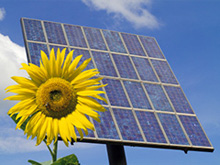Solar Panels, Solar PV, Solar Photovoltaic

Solar Photovoltaic Panels, or Solar PV for short, are rapidly developing technology where daylight is converted into electrical energy to power for your home. Solar Panels use energy from the sun to generate electricity which can operate electrical appliances.
Solar Panels in essence collect the solar power, sunlight and convert it to electricity.
Solar PV Panels (Photovoltaics)
Solar photovoltaic modules create and store electricity through the use of rechargeable modules from the sun's energy within its rays. Solar PV needs daylight; it doesn't have to be direct sunlight, and is therefore possible to create electricity even on cloudy days. Solar PV panels can equally work well in urban or rural situations. The installation is flexible and can be placed on the roof of most homes that can support the equipment and are often easily connected to a building's electricity supply.
Benefits of Solar Panels
- When in use, a Solar PV panels do not generate greenhouse gases or cause pollution.
- Solar power is a renewable resource therefore we are not in danger of depleting its reserves.
- Solar panels produce energy that can power the running of appliances and lighting within the home and emit no carbon emissions.
- Once solar panels or solar thermal collectors are set up, there are no electrical expenses necessary to power them.
- If you generate more than you require you can sell your energy to the utility companies.
- The average lifetime of Solar PV panels can be in excess of 20 years.
- Crystalline silicon modules have a very long life span do not need a lot of maintenance.
- In remote locations, solar energy may be a more realistic possibility than running large amounts of electrical wires to connect to the mains grid.
How much power do solar panels produce?
The level of electricity solar panels can create is dependant on the quality of the solar panel, the materials and technology used in manufacturing the solar panel. Each kilowatt-peak (kWp) of electricity produced can save approximately 455 kilograms of carbon dioxide emissions compared with electricity generated from fossil fuels.
When you buy solar panels, it is a good idea to examine not only the size of the panels but the output ratio.
Types of solar energy installation
Solar Photovoltaic Panels (PV Panels)
A Solar PV installation will cause a minimum disruption to the home and systems can be retrofitted. A typical silicon cell is quite small, approximately about 10cm x 10cm. Individually solar cells only create electricity at a low voltage however when more power is needed multiple cells can be joined together to form photovoltaic modules, or solar panels.
Solar PV Roof Tiles (Photovoltaic Tiles)
Solar PV roof tiles are manufactured to fit into an average normal tiled roof. One edge of the solar tile is place under the row of tiles above; obviously the exposed area contains the Solar PV cells by design. The solar tiles are connected together electrically and have similar attributes of the solar panels, previously described.
Stand-Alone Solar Panel System
A stand-alone Solar PV system maybe a good option where there is no connection to the local mains electricity grid or where the mains electric supply is likely to have reliability issues. If the installation is for a home that is not connected to the mains, then the Solar PV panels can be set up to provide power to a series of batteries. The electricity flow from cells used for storage is in direct current (DC) and this will be converted to alternating current (AC), mains power, by installing an inverter.
Before buying Solar Panels for your home
Current planning guidance encourages local planners to directly consider the requirement for more renewable energy in their regions. Planning permission is often only required on listed buildings or building in conservation areas. In all circumstances it is advisable to discuss the planning issues with the local authority where you plan to install them.
Solar PV systems should always be installed by a trained and experienced installer. Electrical safety regulations oversee Solar PV installations and are required to be met by the installer.
If you are think of purchasing any type of renewable energy system it maybe advisable to improve the energy efficiency of your home through improved, insulation, draught proofing, low energy lights and heating controls. Check out dedicated pages on energy efficient home improvements.

 config
config view
view logs
logs 2048.0 KB
2048.0 KB



